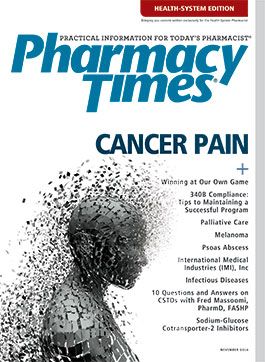Publication
Article
Pharmacy Practice in Focus: Health Systems
Infectious Diseases: New Opportunities for Pharmacists
Society of Infectious Diseases Pharmacists just celebrated its 25th anniversary and has seen sustained growth in its membership, influence, and responsibility since its inception.
It is my pleasure to write to announce a new collaboration between the Society of Infectious Diseases Pharmacists (SIDP) and Pharmacy Times. This partnership will feature content, with an emphasis on antimicrobial stewardship, from antimicrobial-use experts who are SIDP members. If you are wondering, “What’s SIDP?” or “What’s antimicrobial stewardship?,” let me explain.
SIDP (sidp.org) just celebrated its 25th anniversary and has seen sustained growth in its membership, influence, and responsibility since its inception. The profession of infectious diseases pharmacy has evolved considerably and is on the verge of its biggest change to date. Why? It is due to the convergence of several factors: a lack of robust antibiotic development, ever-increasing antimicrobial resistance, and the rise of antimicrobial stewardship programs (ASPs) to deal with these issues.
Antimicrobial resistance is at crisis levels. It has been well reported that the CDC determined, in 2013, that 23,000 people die of antibiotic-resistant infections in the United States every year, and this number does not include the 14,000 deaths from Clostridium difficile infection annually.1 The upward trend in antibacterial resistance is alarming and has caught the attention of the White House. In 2015, it published the “National Action Plan for Combatting Antibiotic-Resistant Bacteria.”2 This high-level report outlined elements of a way forward to address the ever-increasing effects of antibiotic resistance on many fronts, including improved diagnostic tests, accelerated research pathways for new anti-infective agents, provisions to monitor antibiotic use in animals, and spreading ASPs throughout the country. This last point has major implications for pharmacists.
ASPs are designed to systematically monitor and improve antibiotic use throughout an entity, usually an acute care hospital.3-5 These programs already exist in many hospitals and were experiencing rapid growth as a way to combat increased antimicrobial resistance. They are usually run by a combination of infectious diseases pharmacists and infectious diseases physicians,5 but the “boots on the ground” are usually pharmacists. These programs have been shown to not only save money but also improve antimicrobial use, and some studies have shown that ASPs decrease antibiotic resistance and the incidence of C difficile infections.3-5 Most significantly, demonstration of an institutional ASP is about to become a CMS condition of participation for hospitals and long-term care facilities in the United States, as called for in the national action plan.6 CMS responded by including this requirement in its newly proposed conditions of participation for 2017. SIDP and other organizations reviewed and commented on this draft and are waiting for the final standards to be posted.
What does all of this mean? For pharmacists, it is an important opportunity. Although ASPs can take many different forms in hospitals, pharmacists have leadership positions in most of them. In fact, the CDC’s 2015 publication Core Elements of Hospital Antibiotic Stewardship Programs specifies that 1 of these core elements is the appointment of a pharmacist leader to work to improve antimicrobial use.3 Our peers in other professions are increasingly aware of the important roles pharmacists play in antimicrobial stewardship,3-5 and SIDP and other organizations continue to work to keep pharmacists in the spotlight as key members of the antimicrobial stewardship team in not only hospitals but also long-term care facilities.7 This latter setting, a breeding ground for antimicrobial resistance, is the likely “next frontier” in ASP development.
As we work to solidify our central role in ensuring the appropriate use of antibiotics and move our profession forward, SIDP’s members will share with you their insights into the treatment of infectious diseases in this column. Their expertise is wide-ranging and their topics will be, as well. We are hopeful that you will find this Infectious Disease Focus series to be useful.
Jason C. Gallagher, PharmD, FCCP, FIDSA, BCPS, is president of the Society of Infectious Diseases Pharmacists and a clinical professor at Temple University.
References
- CDC. Antibiotic resistance threats in the United States, 2013. CDC website. cdc.gov/drugresistance/pdf/ar-threats-2013-508.pdf. Accessed September 19, 2016.
- The White House. National action plan for combatting antibiotic resistant bacteria. whitehouse.gov/sites/default/files/docs/national_action_plan_for_combating_antibotic-resistant_bacteria.pdf. Published March 2015. Accessed September 19, 2016.
- CDC. Core elements of hospital antibiotic stewardship programs. CDC website. cdc.gov/getsmart/healthcare/implementation/core-elements.html. Accessed September 19, 2016.
- National Quality Forum. Antimicrobial stewardship playbook. National Quality Forum website. qualityforum.org/Publications/2016/05/Antibiotic_Stewardship_Playbook.aspx. Accessed September 19, 2016.
- Barlam TF, Cosgrove S, Abbo LM, et al. Implementing an antibiotic stewardship program: guidelines by the Infectious Diseases Society of America and the Society for Healthcare Epidemiology of America. Clin Infect Dis. 2016;62(10):e51-e77. doi: 10.1093/cid/ciw118.
- CMS. CMS issues proposed rule that prohibits discrimination, reduces hospital-acquired conditions, and promotes antibiotic stewardship in hospitals. CMS website. cms.gov/Newsroom/MediaReleaseDatabase/Fact-sheets/2016-Fact-sheets-items/2016-06-13.html. Accessed September 19, 2016.
- Heil EL, Kuti JL, Bearden DT, Gallagher JC. The essential role of pharmacists in antimicrobial stewardship. Infect Control Hosp Epidemiol. 2016;37(7):753-754. doi: 10.1017/ice.2016.82.







